![[MOVIE] A Glimpse into the World of Sado](https://rimage.gnst.jp/livejapan.com/public/article/detail/a/00/00/a0000527/img/basic/a0000527_main.jpg?20200619182144&q=80)
The tea ceremony undoubtedly is one of the most famous Japanese traditional arts. I already had a chance to participate in one, a few years ago. But, quite frankly, this was at another level.
Entering the Teahouse via the Nijiriguchi

Traditionally, the guests wear a kimono or dark formal clothes, so the first thing I had to do was to change clothes. Putting on a kimono is not something that is easy to do alone, so the help of the staff was most welcome. Once dressed, I got a short introduction on how to enter Hisui’s teahouse, Suian. Modeled after teahouses in the late 16th century, it has what has become a rare feature in Tokyo: a nijiriguchi entrance, or "crawl-in entrance". It is used as a symbolic way to separate the outside world from the simple and quiet area that is the teahouse, and the guest has no choice but to bend when going in.
First Impressions
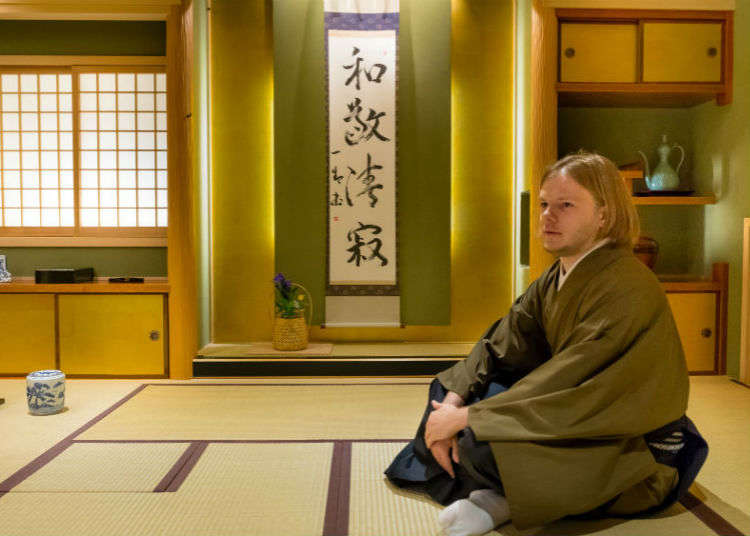
Once I am in, my first observation is that the teahouse is decorated soberly. It doesn’t seem to be very large, even if some teahouses tend to be much smaller. Before starting the ceremony itself, Suiko Ajima explains the different parts that make up a traditional tea room to me, an essential part of this art. In the small alcove, the hanging scroll, or kakejiku, is the most visible. Below it, slightly on the left, a chabana can be seen, a simple flower arrangement. Its composition changes depending on the season, explained my teacher. Together, they set the spiritual mood for the ceremony and were carefully chosen by my host to accompany my first real introduction to the tea ceremony.
The Beauty of Candy
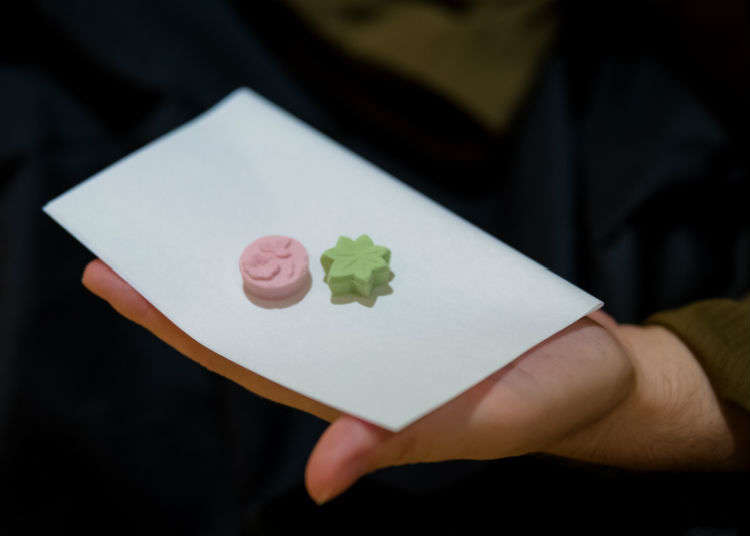
Before moving on to the tea preparation itself, my host and teacher gives me two small treats, bright green and pink, that are placed on a special paper called kaishi. Once those are eaten, she instructs me to fold the paper in half and keep it on my right side, as it will be used again later.
The Elegance of Tea
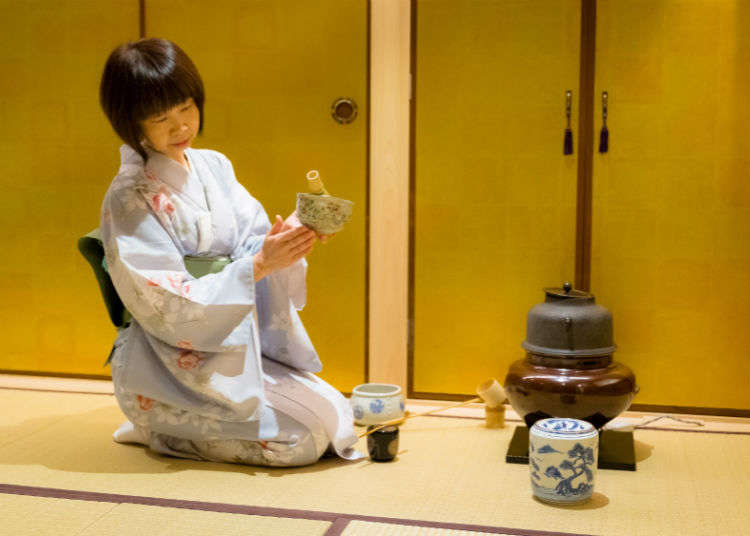
When she started to prepare the tea, Suiko Ajima’s gestures, focus, and movements were, quite frankly, mesmerizing. It is done in such a harmonious manner that it is like watching a meditation in movement. The bowl in which the tea is served is beautiful. An extraordinary insight into wabi-sabi, the Japanese concept of aesthetic that focuses on the acceptance of transience and imperfection.
The Rituals of Drinking
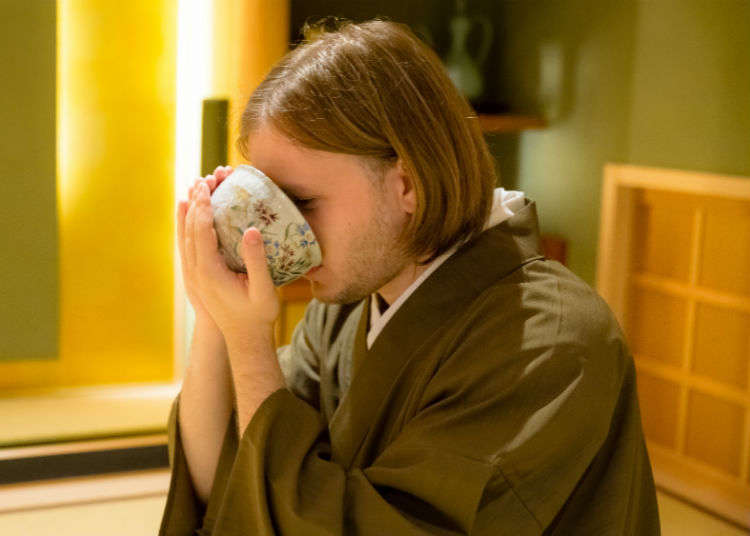
When the bowl is presented to the guest, it is important to take it with the right hand and place it gently on the palm of the left one, my host explains to me. Then, before drinking, I take the time to take a closer look at the beautiful yet simple design on it. After that comes the time to drink the tea. The bowl needs to be turned clockwise two times so that the image on the cup is not facing me anymore. One sip, then I must thank my host for her delicious preparation. After that, I can finish drinking without forgetting to make some sound with the last sip, showing my appreciation. It’s at that moment that the little paper, kaishi, which I folded at the beginning comes to use: in fact, it should be used to wipe the rim of the bowl lightly, where I just drank from.
Lifetime's Training
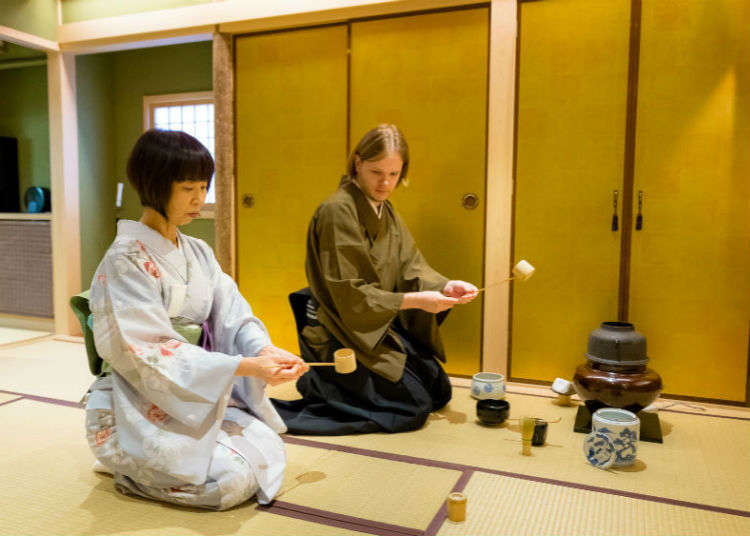
The sequence, known as temae, is, in itself, not very difficult to remember. It consists of putting the green tea from the caddy in the bowl, pouring hot water into the bowl using the ladle, stir it with the whisk and presenting it to the guest. However, doing it right and in a fluid and continuous motion is obviously much harder. Practitioners usually train for several years before being able to host a tea ceremony from the beginning to the end by themselves. So many details but also such a specific mindset for doing it need to be taken into account, it is no wonder why becoming a true master is a lifetime’s work, and is never really over. In the end, I felt like I just had a small glimpse of a whole new world. The tea ceremony is clearly something that is hard to describe with words, and something that should be experienced during a trip to Japan.
A Unique Opportunity to Try Sado
HiSUi TOKYO is located in the heart of Tokyo, only a few minutes away from Ginza Station. For short-term visitors, an “Experience Plan” is available in which you can try between one and four art forms. This includes battō, sadō (tea ceremony), shodō (calligraphy) and wasō (kimono). Price start from 10,000 yen per person. Maximum of 20 people per booking. Reservation by email or phone.
-
HiSUi TOKYOHiSUi TOKYO
- Address 4-3-13, Ginza, Chuo-ku, Tokyo, 104-0061, Japan
Quentin Weinsanto is a journalist living in the area of Adachi-ku in Tokyo. Being in Japan since 2011, he always love to write about interesting stories or places to visit.
- Area
- Category
*Prices and options mentioned are subject to change.
*Unless stated otherwise, all prices include tax.
Popular Tours & Activitiess
Recommended places for you
-
Events

Asakusa Kimono Rental『DAIKICHI』
Culture Experience
Asakusa
-

WASAKE Sake Experience
Culture Experience
Asakusa
-

Ameyoko Shopping Street
Old Towns (Shitamachi)
Ueno
-

Art Café T8 ASAKUSA
Culture Experience
Asakusa
-
Coupons

Puppy Café Rio Shinjuku
Culture Experience
Shinjuku
-

FUJI JAPAN Asakusa
Culture Experience
Asakusa
-

First Japan Cherry Blossom 2026 Forecast Announced! Here's When & Where to See Sakura in Japan
-

New in Ginza! Air BicCamera Ginza Opens with a Faster, More Convenient Shopping Experience
by: Guest Contributor
-
Ad

Discover the "Miraculous Forest" in the Heart of Tokyo: The Institute for Nature Study (9 Minutes from JR Meguro Station)
-
Ad

(Opening in Jan 2026) 'THE SUMO LIVE RESTAURANT HIRAKUZA GINZA TOKYO!' 5 Exciting Ways to Experience the World of Sumo!
-
Ad

Complete Guide to Ueno's National Museum of Nature and Science, the Perfect Place to Visit on Rainy Days or With Children
-

Japan’s Shinkansen Is About to Change Travel in an Unexpected Way
by: Guest Contributor
Inspiration for Accommodations
-

Enjoy Mt. Fuji from the Comfort of Your Room! Recommended Ryokan with Mt. Fuji View
-

Stay Near the Cherry Blossoms! Hotels for Cherry Blossom Viewing in Tokyo
-

Family-Friendly Hotels with Free Shuttle to Disneyland: Convenient Access for a Magical Stay
-

Top Ranked Hakone Hotels with Mt. Fuji View: Enjoy Stunning Scenery from Your Private Space
-

Convenient Tokyo Hotels with Airport Shuttle: Ideal for Families and Heavy Luggage
-

Stunning Tokyo Tower View Hotels: Enjoy Spectacular Scenery from Your Private Space
-

Convenient Asakusa Hotels with Kitchens: Ideal for Extended Family Visits
-

Experience Luxury: Hakone's 10 Best Five-Star Accommodations
-

Enjoy Mt. Fuji Autumn Leaves! Top Hotels Near the Popular Autumn Leaves Corridor
-

Experience Hakone Fall Foliage from Your Room with Stunning Views
-

Kurayami Gohan – Experiencing the Dinner in the Dark
by: Pamela Drobig
-

Exploring Tokyo Station: 11 Must-Visit Spots Around the Heart of Tokyo
-

[MOVIE] Achieve Your Cosplay Dreams at Cosplay Studio Crown!
by: Alex Kobayashi
-

20 Fun Things to Do in and Around Asakusa - Tokyo's Cultural Hub
by: Guest Contributor
-

Healthcare in Japan for Tourists: What to Do When You Get Sick or Injured in Japan
-

Ikebukuro Station Area Guide: Top 15 Spots When You Escape the Station's Maze!
- #best ramen tokyo
- #what to buy in ameyoko
- #what to bring to japan
- #new years in tokyo
- #best izakaya shinjuku
- #things to do tokyo
- #japanese nail trends
- #what to do in odaiba
- #onsen tattoo friendly tokyo
- #daiso
- #best sushi ginza
- #japanese convenience store snacks
- #best yakiniku shibuya
- #japanese fashion culture
- #best japanese soft drinks













